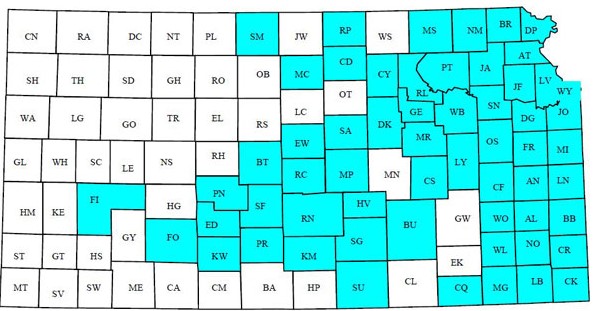By Timothy Todd and Rodrigo Onofre
Soybean cyst nematode (SCN) is a major problem in soybean fields throughout eastern and central Kansas (Figure 1). It is important to monitor SCN levels regularly to determine if management strategies, such as variety resistance and crop rotation, have been successful.

Figure 1. As of January 1, 2021, SCN was identified in 59 Kansas counties that produce >85% of Kansas soybeans. SCN has been detected in counties highlighted in blue. Map courtesy of Timothy Todd.
Confirming the presence of SCN and determining population levels is the basis for a successful integrated management program. Here we discuss the recommended strategy for SCN sampling.
Need help submitting a SCN sample?
Contact your local K-State Extension Office. They will work with you to collect and submit the samples to the K-State Plant Disease Diagnostic Lab. Here are guidelines that can help get a good sample to the lab:
- A soil probe (or sharpshooter spade)
- A bucket
- A labeled bag. Label should include the following information:
- Field identification (i.e. Field ID: North Farm, near Doe Creek)
- Size of the area being sampled (i.e. 20 acres)
- Crop history (i.e. soybean, corn, and soybean)
Recommended field pattern for sample collection
If your field is fairly uniform, divide it into quadrants for your SCN sample collection. Sections of the field that have had different cropping histories or have a different soil type should be sampled separately. For each quadrant or area of the field, you will collect 10 to 20 cores to a depth of 6 to 8 inches.
It is important that when collecting soil cores you walk in a systematic pattern, such as a “Z” pattern (Figure 2). Collect a total of 10 to 20 soil cores, emptying each into the bucket after collection. All core samples should be mixed well, to account for any minor variation between cores. After mixing, collect 1 pint of soil, approximately 2 cups, in a labeled plastic bag and seal.
Figure 2. Example of a good sampling pattern for collecting soil to test for SCN within a field.
When sending your samples to the diagnostic lab make sure to:
- Keep samples refrigerated until shipping
- Send overnight or as fast as possible (time is crucial)
- Avoid leaving bags in the sun (which can kill nematodes)
- Send the samples to the Plant Disease Diagnostic Lab in the K-State Plant Pathology Department.
- You can find the Plant Disease Diagnostic Check sheet at https://www.plantpath.k-state.edu/extension/diagnostic-lab/documents/DiseaseLabChecksheet.pdf
Source : ksu.edu